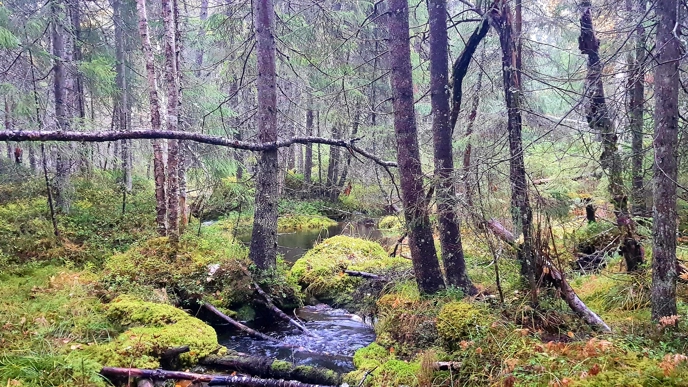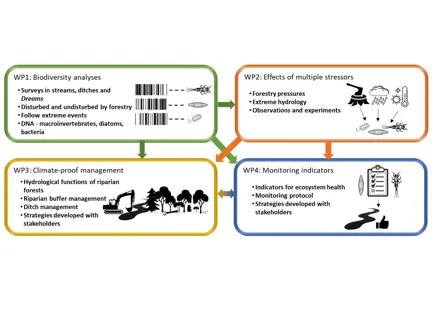
AquaBioEx
KEY POINTS- biodiversity
- small streams
- multiple stressors
Project overview
More related research
Short summary
How to protect what we do not know we have: Identifying, understanding and managing aquatic biodiversity in intensively managed forests and under an increasingly extreme climate
Ongoing climate change and land-use represent severe pressures on boreal waters, most impacting the smallest natural streams and systems created (ditches) or modified (ditched streams that we call Dreams) by humans. In Sweden, extreme drought events and floods are increasingly more common. At the same time, millions of km of small waterways are under pressure from forestry. These anthropogenic pressures represent large threats to biological communities in small waterways, but currently we do not have the capacity to predict their responses, nor to protect them.
AquaBioEx asks the following project questions:
- What are the differences and similarities in biodiversity among natural and artificial small forest waterways?
- How does biodiversity respond to disturbances caused by hydrological extremes, and are those responses influenced by the magnitude of disturbance due to forestry?
- Can we find climate-proof solutions for managing forests along small waterways and thus, prevent biodiversity losses?
- What indicators can be monitored in small forest waterways to effectively evaluate their ecological status, and can they be integrated into regional, national, and international monitoring programs?
Project description
AquaBioEx project was funded within the 2023 Formas call Water, Climate, Biodiversity and is a collaboration between 3 institutions: The department of Forest Ecology and Management (SLU, Umeå), The department of Aquatic Sciences and Assessment (SLU Uppsala) and Ecology and Genetics Unit at Oulu University (Finland) and is led by Lenka Kuglerová (The department of Forest Ecology and Management).
Project structure
AquaBioEx comprises of four inter-connected work packages, each with several tasks.
WP1: Biodiversity analyses
Objective: Describe in detail macroinvertebrate and microbial communities of small waterways (natural streams, Dreams and ditches), in managed and reference forests.
Task 1.1 Large-scale snapshot biodiversity surveys
Task 1.2 Biodiversity following extreme hydrological events
WP2: Effects of multiple stressors
Objective: Assess the impact of extreme hydrological events on biodiversity in systems with and without the underlying pressures from forestry using experiments and field investigations
Task 2.1 Community responses to extreme events in forestry-impacted streams
Task 2.2 Short-term effects of extreme events in forestry-impacted mesocosms
WP3: Climate-proof management
Objective: Develop a framework for forestry best management practices near water to be climate-proofed and to mitigate the impact of forestry and extreme events on biodiversity and ecosystem functions in small waterways.
Task 3.1 Hydrological functions of streamside forests
Task 3.2 Strategies for buffering small waterways
WP4: Monitoring indicators
Objective: Identify indicators for small waterways to develop an improved water monitoring program in managed forests.
Task 4.1 Database work
Task 4.2 Indicators for forest waters and biomonitoring program
